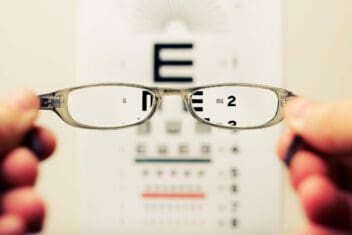
Medically Reviewed by Dagny Zhu, M.D. NVISION Surgeon
WaveLight LASIK: Costs & Differences
Home / Laser Eye Surgery Guide (Updated) /
Last Updated:

Medically Reviewed by Dagny Zhu, M.D. NVISION Surgeon
Wavefront LASIK with the WaveLight laser offers more advanced measurement capabilities compared to traditional LASIK, allowing for highly personalized surgery.
Using wavefront-guided technology, WaveLight LASIK employs a specialized excimer laser that generates a precise 3-D map of your cornea. This detailed map enables a greater level of customization during the LASIK procedure.
Table of Contents
WaveLight LASIK can often offer better corrections, fewer side effects, and a higher likelihood that you will no longer need prescription glasses or contact lenses after the surgery. As a more customizable procedure, WaveLight LASIK costs more than traditional LASIK.
Even if you are not a candidate for conventional LASIK, you can still qualify for WaveLight LASIK, as it can correct a wider range of refractive errors and astigmatism. Recovery from WaveLight LASIK is similar to recovery from traditional LASIK.
What is WaveLigth LASIK?
WaveLight LASIK is an advanced laser eye surgery that uses a specialized excimer laser to provide precise and customizable LASIK treatment. During the procedure, a wavefront analyzer creates a detailed 3D map of the cornea, capturing refractive errors and higher-order aberrations. With this information, the surgeon guides the WaveLight laser to reshape the cornea accurately, correcting refractive errors and optimizing visual acuity.
What sets WaveLight LASIK apart is its ability to measure and address higher-order aberrations, offering enhanced visual outcomes by customizing the treatment to each individual’s unique eye characteristics. The goal is to provide improved vision and a higher quality of vision for patients.
You deserve clear vision. We can help.
With 135+ locations and over 2.5 million procedures performed, our board-certified eye surgeons deliver results you can trust.
Your journey to better vision starts here.
WaveLight and WaveFront LASIK
Wavefront and WaveLight technologies are two distinct parts of a larger LASIK surgery suite.
‘Wavefront LASIK‘ refers to the advanced technology that maps and analyzes the optical characteristics of the eye. It captures the unique pattern of how light waves travel through the eye and identifies any distortions or aberrations that may be present. This information helps in creating a detailed map of the cornea, highlighting both basic refractive errors (such as nearsightedness, farsightedness, and astigmatism) and higher-order aberrations that can affect the quality of vision.
On the other hand, WaveLight is a specific type of excimer laser designed for laser eye surgery. It is equipped with advanced technology that allows for precise and customizable treatment. The surgeon utilizes the wavefront analysis to guide the WaveLight laser during the procedure. The laser reshapes the cornea with remarkable accuracy by removing tissue from specific areas, correcting refractive errors, and optimizing visual acuity.
WaveLight vs. Traditional LASIK

With conventional LASIK, a laser is used to reshape your cornea to correct for hyperopia (farsightedness), myopia (nearsightedness), or astigmatism (irregularly shaped cornea). With WaveLight LASIK, a more advanced technology is used (called wavefront-guided LASIK) that can measure your cornea in greater detail for a more customized procedure.
Wavefront-guided technology uses a computer to make a three-dimensional map of your cornea and its peaks and valleys. This is done in order to completely customize exactly where and how much the laser needs to shape during WaveLight LASIK. This means that it can correct for higher-order aberrations or more subtle distortions.
Here’s a quick overview of how WaveLight LASIK compares to traditional LASIK:
| Features | WaveLight LASIK | Traditional LASIK |
|---|---|---|
| Laser Technology | WaveLight excimer laser | Conventional excimer laser |
| Visual Outcomes | Captures and addresses higher-order aberrations in addition to basic refractive errors (nearsightedness, farsightedness, astigmatism) | Primarily focuses on correcting basic refractive errors |
| Customization | Highly customizable treatment based on individual’s unique eye characteristics | Highly customizable treatment based on the individual’s unique eye characteristics |
| Precision and Accuracy | Utilizes wavefront-guided technology for precise corneal reshaping | Offers precise corneal reshaping with standard laser techniques |
| Treatment Optimization | Detailed 3D corneal map helps optimize laser treatment for better results | Standard laser treatment without detailed 3D corneal map |
| Potential Benefits | Enhanced visual acuity, reduced halos, glare, and other higher-order aberrations | Improved visual acuity and reduced reliance on glasses/contact lenses |
Cost Differences

One of the main disadvantages of WaveLight LASIK is that it costs more than traditional LASIK.
Conventional LASIK procedures can range from $1,000 and $3,000 per eye on average. It is also considered an elective and cosmetic procedure and therefore is not covered through insurance.
WaveLight and wavefront-guided LASIK uses specialized technology for a more personalized and customizable approach. As a result, it will cost more.
Typically, WaveLight LASIK is going to cost you about $500 more per eye than standard LASIK. Cost can vary based on the surgeon, their experience and skill level, your location, and the office or clinic where the procedure will be performed.
You deserve clear vision. We can help.
With 135+ locations and over 2.5 million procedures performed, our board-certified eye surgeons deliver results you can trust.
Your journey to better vision starts here.
Advantages of WaveLight LASIK
WaveLight LASIK using wavefront technology can potentially correct your visual acuity to 20/40 or even 20/20 after the surgery, which can often mean that you will no longer need to wear prescription eyewear. WaveLight LASIK is more likely to reduce your need for glasses or contacts than traditional LASIK.
Some of the additional major benefits of WaveLight LASIK over conventional LASIK include:
- More precise measuring of the cornea.
- Fewer side effects, such as reduced night vision, dry eye, and contrast sensitivity.
- Ability to correct more subtle corneal distortions.
- More personalized and customizable abilities.
Thanks to the more precise measurements taken through the wavefront-guided technology, WaveLight LASIK has fewer complications and side effects postoperatively.
Who Should Consider WaveLight LASIK?
People with higher degrees of myopia and astigmatism are often not candidates for traditional LASIK, as this procedure cannot account for higher-order aberrations and distortions. WaveLight LASIK can open the door to more people. Even if you do not qualify for conventional LASIK, the more customizable WaveLight LASIK may be an option for you.
WaveLight LASIK also has a better chance of reducing your need for glasses or contacts after the surgery than standard LASIK, so it is worth considering if this is your goal. Talk to your doctor about the benefits of wavefront-guided LASIK and if this type of customization will be better for your eyes and lifestyle.
What Is Recovery Like After WaveLight LASIK?
The recovery for WaveLight LASIK is not unlike recovery from traditional LASIK. Your vision can clear within hours of the procedure, and you can often return to work and most tasks by the next day. You will need to have a follow-up appointment within a few days of the surgery and attend regular check-ins for the first few months.
Be sure to follow all postoperative directions in order to ensure the fewest side effects and optimal recovery.
You deserve clear vision. We can help.
With 135+ locations and over 2.5 million procedures performed, our board-certified eye surgeons deliver results you can trust.
Your journey to better vision starts here.
References
- Alternative Refractive Surgery Procedures. (September 2017). American Academy of Ophthalmology (AAO).
- LASIK FAQs (Frequently Asked Questions). (July 2018). U.S. Food and Drug Administration (FDA).
- WaveLight. (July 2006). U.S. Food and Drug Administration (FDA).
- Laser in Situ Keratomileusis. (July 2020). StatPearls Publishing.

Dr. Dagny Zhu is a nationally acclaimed, Harvard-trained specialist in cornea, cataract, and laser refractive surgery. As a key opinion leader in advanced laser vision correction and cataract surgery, Dr. Zhu has been featured in over 200 lectures, presentations, publications, and press features.
This content is for informational purposes only. It may have been reviewed by a licensed physician, but is not intended to serve as a substitute for professional medical advice. Always consult your healthcare provider with any health concerns. For more, read our Privacy Policy and Editorial Policy.
